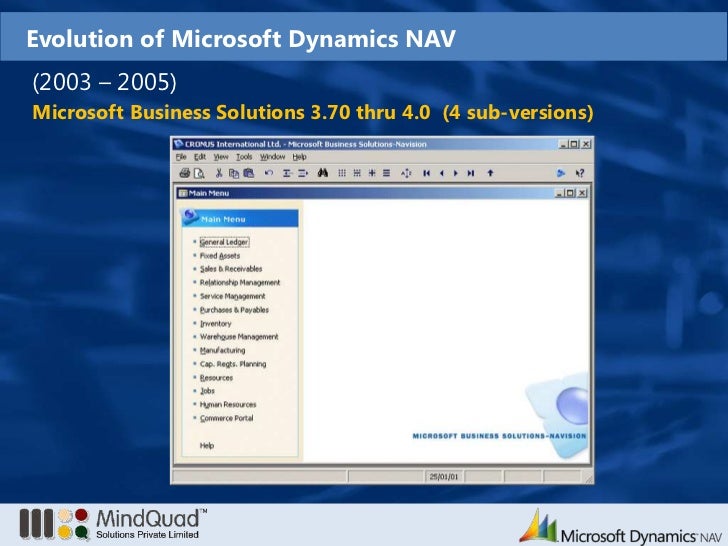- Microsoft Dynamics Nav Download
- Microsoft Dynamics Nav 2009 R2 Download Crack Download
- Microsoft Dynamics Nav 2009 R2
In previous versions, all local client settings are stored in the .zup file. In Microsoft Dynamics NAV 2009, this is a bit more complex. This post tries to describe which settings are stored where.
In addition to that, with NAV 2009 you may be spending a lot of time looking for files with long folder-names. So this post also shows you the location of each file, to make it quicker to find them.
Make a full SQL backup of the Microsoft Dynamics NAV 2009 R2 database. Run form 104001, Upgrade - Old Version, and then choose the Delete Objects action. Uninstall Microsoft Dynamics NAV 2009 R2 or Microsoft Dynamics NAV 2009 SP1. Change the compatibility level of the database by using SQL Server Management. Client for NAV 2009 R2 Version GB 6.0 (6.00.32012) I am looking for the download client for NAV 2009 R2 Version gb 6.0 (6.00.32012) however all material on the partnersource and customersource.
/// Blog updated October 2nd: Section “temporary server files” updated with path for Windows Server 2003.

Announcing Microsoft Dynamics NAV 2009 R2: December 15,2010. Announcing Date for General Availability of Microsoft Dynamics NAV 2009 R2. We are pleased to announce General Availability date to be December 15, 2010 for Microsoft Dynamics NAV 2009 R2. The download links would have been: I have already sent Microsoft my feedback to add the missing content, so maybe at least us partners will get this material soon. But there is also an online training available: 80597 Service Management in Microsoft Dynamics NAV 2013 R2 (!). Download Microsoft Dynamics NAV Driver. Archived Forums Windows 10 General. I have a windows 10, and this company I am working for has MS Dynamics NAV 2009 R2.
Microsoft Dynamics Nav Download
Setup files and tables in NAV 2009
In NAV 2009, settings are stored in various places. The following lists what is stored where. some settings are stored in files, and some in tables. I hope I have included everything here. But if the list should be incomplete, I would appreciate comments at the end of this post.
Client side:
PersonalizationStore.xml
stored in:
%AppData%MicrosoftMicrosoft Dynamics NAV
This file stores some personal settings for the client like resizing of columns. It is probably the closest thing to the old zup file there is. The data in this file is primarily binary because it it not supposed to be updated manually. Even if you could edit the file (if you could find the settings you wanted to edit), then this is unsupported. But, like the old zup file, you can delete or rename it, and next time the client opens, it will create a new one.
ClientUserSettings.Config
Stored in:
%ProgramData%MicrosoftMicrosoft Dynamics NAV
This file is where you can set RTC to connect to a specific service tier and/or a specific port.
Server side:
CustomSettings.config
stored in (default):
C:Program FilesMicrosoft Dynamics NAV60Service
This is where you set up parameters for the Service Tier like SQL Server name, Database name, port number etc.
temporary Server files
Stored in:
%ProgramData%MicrosoftMicrosoft Dynamics NAV60Server
/// Update
The path above is for a Vista OS. If you run NAV server on Windows Server 2003, the path is:
C:Documents and SettingsAll UsersApplication DataMicrosoftMicrosoft Dynamics NAV60Server
Microsoft Dynamics Nav 2009 R2 Download Crack Download
/// —–
The service tier uses this folder for various temporary files. It is definitely not recommended to change any files here! But it might be a place for troubleshooting certain problems (though I am not sure what kind of problems).
Tables:
2000000075 – “User Metadata”
When you go to “Customize this page”, then it’s stored here.If for example a user ads new parts, like a chart or does anythign else herel,this table contains one record for each urse, for ach pae that they have persinalised.

Microsoft Dynamics Nav 2009 R2

2000000071 – “Object Metadata”
This table stores all the objects for RTC. Whenever you compile an object, it transforms it to a format that is designed for RTC and stores it in this table. You can delete entries here, though I would not recommend it. But if you do, and want it back, then compile the missing object from Object Designer. The data in this table is generally binary, so also not something to modify and definitely not necessarily supported or documented.

Lars Lohndorf-Larsen (Lohndorf )
Microsoft Dynamics UK
Microsoft Customer Service and Support (CSS) EMEA